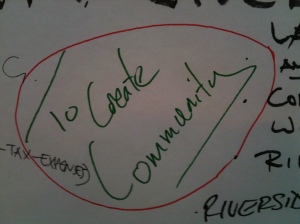Last Friday I went along to a State of Design Festival event, The Reinvention of Fishermans Bend. This is not a real project and the outcomes of the workshop are hoped to stimulate discussion rather than to dictate policy. However, our invitation at the start of the day, as delivered through the Melbourne City Council staff member’s address, was that it was not to be ‘Pie in the sky’ thinking. The room was told that we have to be mindful of how our plans would impact on the rest of Melbourne and that part of the challenge is to work out, ‘how do you reinvent and renew without scaring.’ We were ‘reminded’* that less dense communities are less connected. The assumption was that the most valuable use of the land is as residential.

Notes from a group which even considered taxation- but this did not make it into their final presentation
In questions directed at the representative from the City of Melbourne people did not swallow whole the idea that the port will be relocated and that industry with go elsewhere. However, the room was encouraged to think of the Port relocation as happening over the next 15-20 years and that putting heavy industry with residential as a bad idea because, ‘communities don’t like it.’
The area under consideration was pretty much all of Fishermans Bend and Web Dock, minus the Port Phillip land, so it was very different to the area set out by Matthew Guy. Groups of four to five people worked on five different precincts carved out of the area, generally divided along existing roads. As the precincts were very large (eg the whole of Web Dock or the space between Web Dock and the Westgate), the sort of considerations given to spaces in the final presentations were rather large scale. For example, one plan included ‘bio-hubs’, but did not drill down to discuss where people who work in these structures might have lunch.
Where the precincts were located did factor into how people spoke about the opportunities and constraints, although these considerations were not usually directly related to my interest in the social side of a place. For example, one ‘constraint’ list included ‘proximity to hostile land uses’**, and a ‘green link to CBD’ or renewing a ‘statement to Westgate’ were noted as as opportunities.
My group possibly took the challenge of feasibility a bit too far, aside from when we broke a planning taboo by reducing the potential for waterfront residential development (complete with concerned looks, mutters and even a direct intervention staged by members of other groups). Basically, my group was concerned about mapping out in too greater detail what will be there because we were not sure what would be needed in 50 years time. Our group leader explained in the final presentation that our site would ‘respond’ to what was happening in other precincts.
Seeing as the enthusiasm many people brought to the event seemed to come from their positive experience of working on ‘Punt Paradise’ last year, I am not sure if the focus on feasibility left people as inspired. It was a great privilege to get a glimpse into what experts think should happen with this land which almost surrounds my field-site, and I look forward to seeing what the edited photos and collated information from the event suggests.
* This person got me a bit offside earlier in his talk through inaccuracy; he conflated the history of the Duncan Estate in with Garden City and suggested that nearly half of 23 is 14. While getting things wrong on an off the cuff talk is excusable, these errors were used to make his vision for the future seem grounded in (his made up) past.
** As participants worked in design/ planning/ consultation/ projects I think this sort of ‘planning speak’ was justified.
